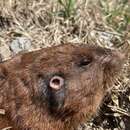en
names in breadcrumbs


Queretaro pocket gophers were previously recognized as Pappogeomys neglectus.
It has been noted that in captivity when one pocket gopher senses that another is near, it will rub its lower incisors against its upper incisors to make a clicking noise. It will also hiss.
Communication Channels: tactile ; acoustic ; chemical
Perception Channels: tactile ; acoustic ; chemical
Queretaro pocket gophers are considered a critically endangered species by the IUCN Red List of Threatened Species.
US Federal List: no special status
CITES: no special status
Queretaro pocket gophers are seen as pests by local people because their burrows and feeding habits harm trees and crops. Otherwise, there are no known adverse affects of these animals on humans.
Negative Impacts: crop pest
Little information is available about any benefits Queretaro pocket gophers provide to humans. It has been suggested that Buller's pocket gophers have a positive effect on agriculture because their burrowing helps to aerate and fertilize the soil. It is possible that Queretaro pocket gophers have a similar impact.
Several types of animals use burrow systems made by Queretaro pocket gophers. These include spiders (Araeneidae), centipedes (Chilopoda), beetles (Coleoptera), springtails (Collembola), flies (Diptera), crickets (Orthoptera), mesquite lizards (Sceloporus grammicus), and Yarrow's spiny lizards (S. jarrovi). Their burrow digging helps to aerate and mix soil nutrients and their foraging impacts plant communities where they occur.
Ecosystem Impact: creates habitat
Mutualist Species:
Queretaro pocket gophers eat roots and stems from a variety of plant and tree species. Captive animals also eat corn, alfalfa, carrots, lettuce, and potatoes. They shake food items before ingesting them.
Plant Foods: roots and tubers; wood, bark, or stems
Foraging Behavior: stores or caches food
Primary Diet: herbivore (Lignivore)
Queretaro pocket gophers (Cratogeomys neglectus) are found only in the northeastern part of the state of Queretaro, Mexico. They are located in a small range of mountains known as the Sierra del Doctor, which is part of the city of Pinal de Amoles.
Biogeographic Regions: nearctic (Native )
Queretaro pocket gophers live in mountainous regions where the habitat is transitional between oak and pine forests. The majority of their activity occurs in agricultural areas that are next to pine forests with many trees and low vegetation. Dark mounds of soil, which indicate the presence of their tunnels, are often seen on hillsides and in agricultural fields.
Range elevation: 2570 to 2896 m.
Habitat Regions: tropical ; terrestrial
Terrestrial Biomes: forest ; mountains
Other Habitat Features: agricultural
Data on the lifespan of Queretaro pocket gophers are not available. Buller's pocket gophers live to be about 5 years of age.
Queretaro pocket gophers are small animals with soft, shiny hair. They have a spindle-shaped body, strong forelimbs, reduced external ears, and a short, thin tail, as is typical of other members of the family Geomyidae. The hair on their backs is dense and gray to yellowish-brown, while the hair on their bellies is thinly scattered and gray to yellowish-red. They have whitish hairs on the throat and bottoms of the hind feet. Around their ears, the hair is dark brown, and their tails are sparsely covered with reddish hairs.
These animals have well-developed cheek pouches with openings outside the buccal cavity. Their procumbent incisors protrude from the mouth even when it is closed.
Males and females are sexually dimorphic in size. Males can weigh from 183 to 500 g and are 220 to 370 mm in length. Females can weigh from 290 to 360 g and are 260 to 304 mm in length.
Range mass: 183 to 500 g.
Average mass: 395 g.
Range length: 260 to 370 mm.
Other Physical Features: endothermic ; homoiothermic; bilateral symmetry
Sexual Dimorphism: male larger
Several carnivores reportedly prey on Queretaro pocket gophers. These include tejons (Nasua nasua), long-tailed weasels (Mustela frenata), coyotes (Canis latrans), and gray foxes (Urocyon cinereoargenteus). Also, two species of snakes, Queretaran blotched rattlesnakes (Crotalus aquilus) and Mexican pine snakes (Pituophis lineaticollis) are predators of Queretaro pocket gophers. Queretaro pocket gophers avoid most predation through their fossorial and nocturnal life style.
Known Predators:
There is little information on the mating system and behavior of Queretaro pocket gophers, but in a close relative, Cratogeomys tylorhinus, the sexes meet only to breed.
Another species in the family Geomyidae, Buller's pocket gopher (Pappogeomys bulleri), is believed to be polygynous. These animals are also solitary except when breeding.
The breeding season for Queretaro pocket gophers starts in early spring, when burrowing activity increases. Little information is available about the reproductive cycle of this species. However, a pregnant female was acquired by Leon et al. (1990); this female had two embryos.
Buller's pocket gophers, a related species, breed year-round, but most mating takes place in the spring. Males and females reach sexual maturity at an age of nine months to one year. After a gestation period of about 20 days, a female will give birth to a litter of two to eleven offspring. In two months the young are weaned and they leave their mother.
Breeding interval: Breeding intervals in Queretaro pocket gophers are unknown.
Breeding season: The breeding season starts in early spring, its duration is unknown.
Key Reproductive Features: iteroparous ; seasonal breeding ; gonochoric/gonochoristic/dioecious (sexes separate); sexual ; viviparous
There is little available information regarding parental investment and care in Queretaro pocket gophers. However, in Buller's pocket gophers, all parental care is performed by the female. She provides protection and nourishment to her offspring until they are weaned. Since Queretaro pocket gophers are solitary, it is likely that females of this species also fulfill all of the parental responsibilities.
Parental Investment: altricial ; pre-fertilization (Provisioning, Protecting: Female); pre-hatching/birth (Provisioning: Female, Protecting: Female); pre-weaning/fledging (Provisioning: Female)